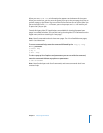
Chapter 1 Executing Commands 23
Modifying Flow Control
Many commands are capable of receiving text input from the user and printing text
out to the console. They do so using standard pipes, which are created by the shell and
passed to the command automatically.
The standard pipes include:
 stdin—The standard input pipe is the means through which data enters a
command. By default, this is data entered by the user from the command-line
interface. You can also redirect the output from files or other commands to stdin.
 stdout—The standard output pipe is where the command output is sent. By default,
command output is sent back to the command line. You can also redirect the output
from the command to other commands and tools.
Â
stderr—The standard error pipe is where error messages are sent. By default, errors
are displayed on the command line like standard output.
Redirecting Input and Output
From the command line, you may redirect input and output from a command to a file
or another command. Redirecting output lets you capture the results of running the
command and store it in a file for later use. Similarly, providing an input file lets you
provide a command with preset input data, instead of having to enter that data.
In addition to using file redirection, you can also redirect the output of one command
to the input of another using the vertical bar character, or pipe. You can combine
commands in this manner to implement more sophisticated versions of the same
commands. For example, the command man bash | grep “commands” passes the
formatted contents of the bash man page to the grep tool, which searches those
contents for any lines containing the word “commands.” The result is a listing of only
those lines with the specified text, instead of the entire man page.
See the bash man page for more information about redirection.
Redirect Description
> Use the greater-than character to redirect command output to a file.
< Use the less-than character to use the contents of a file as input to the command.
>> Use a double greater-than to append output from a command to a file.


















